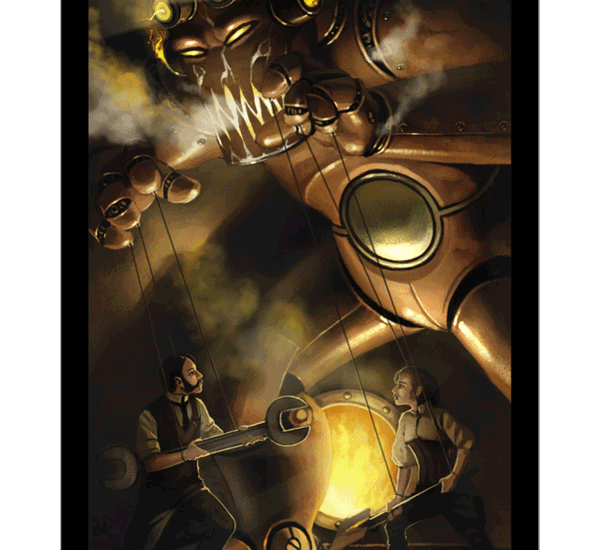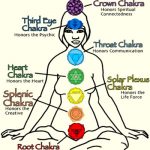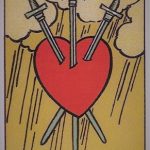Grandpa: There’s a terrible fight going on in inside of us between the wolf of fear and the wolf of love.
Grandson: Which wolf will win?
Grandpa: The one we feed.
Cherokee Legend
I love THE DEVIL (XV) card in Moore and Fell’s Steampunk Tarot. I am addicted to the wonderful artwork and have spent ages staring at each card, so the irony of writing a blog which begins with this card is delicious.
In the Rider-Waite-Smith tarot deck, THE DEVIL (XV) (sign of Capricorn) represents how we are chained to toxic relationships, addictions, and obsessions though the chains are loose. With a bit of effort we could break them but we don’t because they are familiar and we take pleasure from them. The devil sits above the chained humans and laughs.
What is so fabulous about the Steampunk interpretation of this card, as we can see above, is that the devil is clearly something we’ve created, something we have to feed and fan the flames in order to keep it going.
Changing state
In When things fall apart, Pema Chödrön summarises all experiences as the eight worldly dharmas: pleasure and pain, loss and gain, fame and disgrace, and praise and blame. I love the succinctness and binary clarity, it’s so like a computer in which there are only two states 1 or 0, on or off. Of course, life is not that simple, and we all do our best to acknowledge the continuum from say pleasure to pain with the many stops along the way. But, unlike a computer, we have trouble switching from one to another since they come from our life experiences, our triggers and the battles going on within us.
The devil is in the details
So what comes first thinking or feeling?
Life coach Martha Beck in Finding your own North Star breaks down our feeling states into: mad, glad, bad, sad. These are the building blocks as our more complicated emotions are a combination. For example, regret is a mixture of feeling mad and sad and knowing how you feel can help you feel better.
There are also the five stages of grief by Kubler-Ross and Kessler: denial, anger, bargaining, depression, acceptance, and in The Function of Emotions (ed.) Heather C Lench), the emotions are: fear and anxiety, sadness, grief, boredom, jealousy, anger, love and caregiving, happiness, awe, excellence, and how they are guides to help us, which makes it all the more important to recognise what we are feeling.
Pixar’s Inside Out film chose five emotions too: joy, sadness, fear, disgust, anger. Originally they had six but dropped logic so that they could allow Riley’s emotions to rule her for the purposes of story which makes sense as you don’t want logic (or reason) butting in part way through your plot and sorting everything out.
Pixar based their choices on psychologist Paul Ekman’s research. He has spent a lifetime studying emotion, micro-emotions and facial expression. Ekman says we have between five and 27 states, which are neatly summarised in the lovely interactive tool called the Atlas of Emotions which demonstrates how our emotions are layered and triggered from past experiences that lead to various reactions.
A rainbow of emotions
Psychologist Robert Plutchik uses a colour wheel of eight basic emotions: joy, trust, fear, surprise, sadness, anticipation, anger, disgust. The different shades of colour demonstrate how the emotions change when they intensify and what their opposites are: joy/ sadness, fear/anger, anticipation/surprise, disgust/trust.
Using colour is what we do in fiction and life: red mist of anger, feeling blue, and so. There are loads of lovely websites on colour and emotions for creating a good user experience with colour in design. And, I loved thinking about our colours and feelings using the Vedic Chakra systems which I then put into Maslow’s hierarchy of needs and called it Maslow’s hierarchy of chakras.
There are seven colours in the rainbow and seven chakras. In human-computer interaction, we all know that we must chunk down our choices using Miller’s Law to not more than seven (7±2) in the correct serial order. Seven is a mystical number. In the Tarot seven is the number of change, breaking away, and all not being as it seems, like the Chariot, which leads us to the seven deadly sins and their opposite the seven Christian Virtues: pride/humility, greed/charity, lust/chastity, envy/gratitude, gluttony/temperance, wrath/patience, sloth/diligence.
My favourite metaphysical emotional contemplation is found in Colour and Healing for the New Age by Ursula Roberts who says that rose-pink is from the heart [chakra], and even if your loved ones are no longer around as the object of your love, love lives on within your heart. Ruby blood-red wisdom comes from heartbreak and sacrifice often in service to other. These jewels should be treasured because they symbolise progress along the pathways of life.
I find it comforting to think that even our worst life experiences can be transmuted into wisdom.
O Joy, that seekest me through pain,
O Love, that wilt not let me go, George Matheson
I cannot close my heart to Thee;
Colours of Raven
As I was writing this, my eldest came in and asked what I was doing. She wasn’t surprised as I often talk about feelings: mine and everyone else’s. I want everyone to be able to articulate what is in their hearts, in order to feel better, because ultimately isn’t that the goal of anything we ever do?
She told me about an episode of Teen Titans Go Colors of Raven, in which a prism splits Raven into five core parts of her personality: passion, rage, happiness, laziness, timidity. So, we watched the episode and it made us laugh, and I remembered my blog of a rhumba of Ruths about the different personalities of me, which begs the question when do the feelings we have become part of our core?
This leads us back to the question of thinking or feeling and which came first?
In her book Forgiveness, Iyanla Vanzant says that our memories have an emotional charge either negative or positive which is why we still feel them, and if we keep remembering the events of our lives without neutralising the negative, then we will cause ourselves more pain.
I read somewhere that we only ruminate on what causes us pain because our mind, or our ego, or some part of us, wants to fix it and avoid it ever happening again. But, by ruminating we often become bound to that thinking and feeling state for we create new neural pathways in our brain to support that habit of thought. And, moreover after a while, we may start to believe it, because as Abraham Hicks says: A belief is a thought we just keep thinking.
So perhaps that is our answer, feeling then thinking. Our job is to not become our feelings but to honour them as a guide and treat ourselves with compassion, for:
At the core of our deepest longing is to be friends with ourselves.
Matt Licata
And, it is only when we have compassion for ourselves that we can extend it to others.
The inverse of THE DEVIL (XV) is THE LOVERS (VI) (sign of Gemini), which symbolises earthly or heavenly love and union, and sometimes the lovers is about making a choice. Perhaps, the choice of which wolf to feed.
Feed love and on the days when you can’t help but feed fear, forgive yourself, and know that you have all the love you need rose pink, deep inside your tender ruby jewelled heart.








3 comments